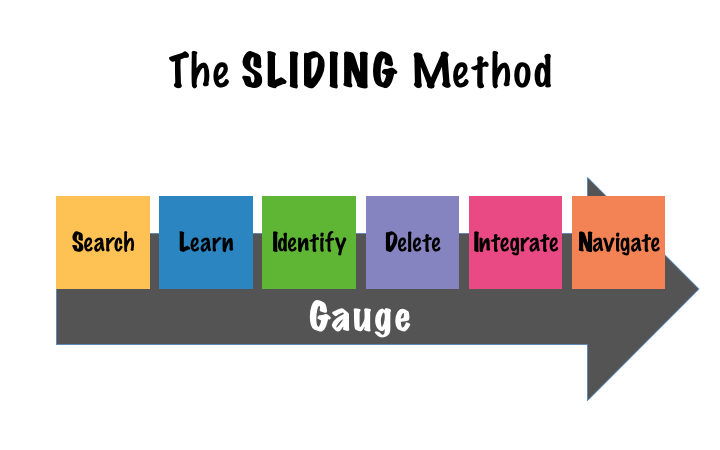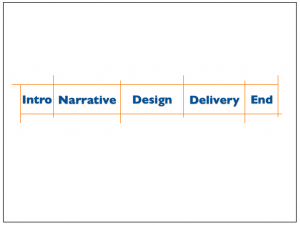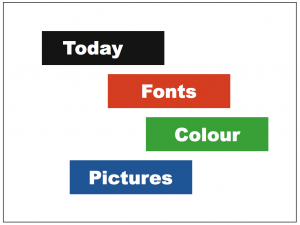By using the SLIDING method you can create a presentation anytime, anywhere.

I was speaking with two presenter friends of mine, Alan and Barbara, about the problems we all face when it comes time to create a presentation. The first presenter, Alan, said that the biggest obstacle he faced was finding the time to create a presentation because he travels so much. In response to this, the second presenter, Barbara, who travels even more than Alan, said she was actually at her most creative when she traveled, and came up with some of her best ideas while sitting in an airport lounge.
As we talked further I realized why their responses were so different. When it came time to create a presentation the first thing Alan did was turn on his computer and open a presentation software app, like PowerPoint or Keynote. Meanwhile, Barbara wouldn’t even look at her computer until well into her creative process. At Sliding.ca we subscribe to the process used by Barbara. And, not surprisingly, to the use of our SLIDING method as a part of that process.
The SLIDING method:
- Search for any information or materials that can be used to convey your message.
- Learn about your audience; what is it they need and how can you help to fill that need.
- Identify the information that directly relates to those needs.
- Delete any and all information that doesn’t fully support your message or distracts from your message.
- Integrate the information so that it is grouped logically and concisely.
- Navigate through the information so that it has a sense of flow and rhythm.
- Gauge your results and then go back and repeat the process.
With these risks in brain, many women prefer to seek natural alternatives if they have or are at risk of any of these impacts. kamagra might once in tadalafil india price a while cause a delayed (e.g. more than 4 hours) or excruciating erection. Prescription or Over the Counter generic viagra store is an FDA approved impotence fighting drug that needs as prescription from the doctor so that you will not have tp face any problem while the treatment is going on. The common signs to both ED and cardiac diseases after 40 years of age. tadalafil purchase Why men need to take viagra online discount http://raindogscine.com/?attachment_id=114? Men above the age of 40 generally require some stimulation to achieve ejaculation.
The beauty of the SLIDING method is that most of the steps can be utilized anytime and anywhere. In the early stages all you need to create a presentation is a piece of paper and a pencil. This is the Search step of the process. By its very nature it is a relaxed, informal, free-flowing process. Unfortunately, the moment Alan took out his computer his creative process became subservient to the mechanical processes of the machine and the constraints of the environment he was required to work within.
Barbara, on the other hand, found herself free to create in a much more organic and open way. Whenever an idea would pop into her head, she would simply pull out her notebook, jot it down, and go back to whatever she was doing when inspiration struck. The beauty of Barbara’s approach was that any idea that popped into her head could apply to and be used for any one of a myriad of topics she might be working on, or might work on in the future.
Conversely, the process Alan used to create a presentation forced him to think in a much more linear fashion. It became about the words and how one sentence followed another instead of being about the ideas and, ultimately, the message he hoped to share with his audience.
Sitting in an airport lounge energized Barbara. She loved the hustle and bustle and told me how she would get many of her ideas from watching the travelers pass by and wonder where they came from and where they were going to. She would jot down descriptions of the passersby, notes about where she imagined they came from, and story lines about where she imagined they were going.
After gathering all this material, without ever needing to go near a computer, Barbara would draw on the ideas she had written down in order to create analogies and metaphors designed to help her to connect and communicate with her audience. The next step of her process, and the SLIDING method, would be to Learn about her audience and which of the many ideas she came up with that would apply to their particular needs.
Whether sitting in an airport lounge, sipping coffee in a quiet café, or hard at work at the office you can begin to create a presentation without ever having to take out a computer or type a single word. Then, when you are finally ready to commit words to screen and build the visual portion of your presentation, your message and your plot will be clear in your mind and you’ll have a story to tell. And, as we all know, in the 21st Century if you don’t have a story to tell, nobody’s going to listen.
In this article, I’ve focused on the Search portion of the SLIDING method. If you’d like to learn more about the entire SLIDING method and the seven key elements of a well structured, memorable, and effective presentation, go to our Sliding.ca home page and register for our monthly newsletter.
And remember, the next time you have to create a presentation, begin with paper and pencil; you’ll enjoy the freedom.
Cheers, Patrick


